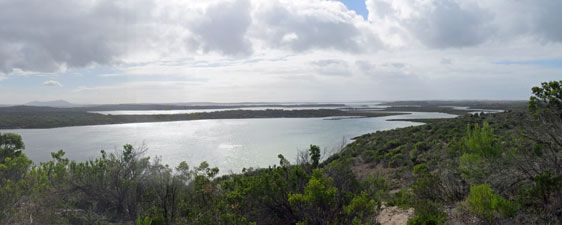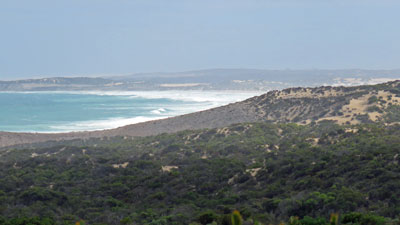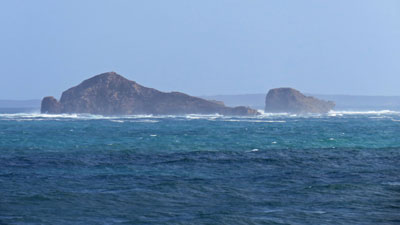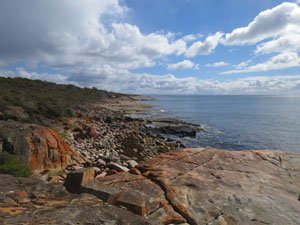| Eyre Peninsula Coast Walks |
About |
We had three days in Port Lincoln and planned to walk on two of them. The arrival of the remnants of Cyclone Seroja made it easy to decide which days to walk on, as it turned our first day into a wild one, with strong gusting winds and rain squalls. We hunkered down in the town and caught up with shopping and chores. I had planned two walks in this lower part of Eyre Peninsula, to explore the coastal landscapes of Coffin Bay National Park and Lincoln National Park. |
|
 Coffin Bay National Park |
 Lincoln National Park |
Most of the park roads at Coffin Bay are serious 4WD terrain, passing through deep sand and rough blocky limestone platforms. I had hoped to walk the Black Rock track, crossing the peninsula from Coffin Bay to the ocean, but discovered that its start and end points were well into 4WD territory and beyond the capabilities of our low-clearance AWD. Not to be outdone, I mapped out an off-track walk of my own, starting and ending in Yangie Bay, which has sealed road access - it would cover the same landscapes but in a more accessible part of the park. The Lincoln National Park walk was both similar and different - again the sea was the dominant part of the landscape, but with the calmer waters of St Vincent Gulf and five small beaches instead of one huge one. The limestone hinterland had a more open mallee heathland and the well-formed tracks made it accessible. The scenery was not quite as dramatic, but the walking a lot easier. The two walks complemented each other nicely. |
|
Avoid Bay Circuit - Coffin Bay NP (12.5 km - 185m ascent - 185m descent) |
Coffin Bay is an half-hour drive west of Port Lincoln. Arriving at the village, we continued on to enter Coffin Bay National Park and travel by sealed road to Yangie Bay and its campsite. Here we started our mainly off-track walk. The first part was a short climb from the car-park up to Yangie Lookout, a limestone knob covered in scrubby heath. From its top, we could look out over the indented edges of Yangie Bay, glistening in the morning sun, to the distant silhouette of the Marble Mountains. Behind us, a patch of blue ocean lay at the rear of a sea of dense green coastal heath - it was our route to the Avoid Bay and, from here, looked just a little daunting.
|
Descending from the lookout, we reached the main road and, after a false start along a limestone ridge, which quickly lead into impenetrable heath, we headed back the short distance to the car park to start again. this time we followed a faint track that headed into the heath along the perimeter of a revegetation area. Unfortunately, it soon vanished and we found ourselves picking our way through gaps in the dense head-high heath. Luckily, this brought us in to a longish depression with low vegetation and we made rapid headway towards the coast. |
|
 Looking across the heathland to Golden Island |
 The southern coast of Coffin Bay National Park |
 Deep in the scrubby heath |
 |
 Finally, the sand dunes and the sea |
Not for long though, as it ran out, whereupon commenced a meandering bush-bash through the dense scrubby vegetation, crossing small dune and depression, as thickets and dead branches forced changes of direction. It was classic scratchy bush-bashing, but eventually brought us out on a high and more open dune ridge, where the sound of the ocean waves urged us on to break out at the coast. It had been a hard won 1.8 km crossing that took us more than an hour. What a coast it was, the wild isolated 7 km of Avoid Bay stretching out before us from Point Avoid to Black Rocks, pounded by line after line of big surf. The hard work was certainly worth it and we had a rest stop in the dunes to take it all in. |
||
|
|
From here the walking was much easier, as we dropped down on to the limestone slab that formed the top of a line of jagged eroded cliffs. We headed westwards to follow the cliff-line, partly along a remnant sandy track, unused by humans, but from the prints in the sand, well used by emus. This led us to a small point, with some superb rock formations below, a small arch and sculpted off-shore rocks, against which the big surf exploded in bursts of foam.
|
 The ancient limestone cliffs |
 Looking westwards |
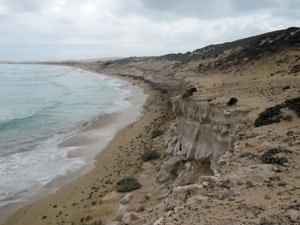 Big tide and low cliffs |
We picked our way along the jagged and gradually lowering cliff line to reach a point where we could drop down on to the beach, with the roaring surf and negative ions generated by the cool westerly wind. Unfortunately, it was high tide and the occasional big wave did not allow much beach to walk on. We retreated higher up the limestone shelf and found a place out of the wind for lunch. |
||
 A sandy section of the coastline |
 |
 The might of the Southern Ocean |
 A short section of beach-walking |
 An arid limestone landscape |
 A small sandy knob with superb views |
Ahead we could now see the massive dune system stretching out into the distance. We began to head inland across an arid bed of limestone, populated with scattered prostrate succulents, to reach a small sandy knob. From this high point, we had a magnificent 360° panorama of dune, beach and wild ocean, and ... in the distance, racing across the sand, we spotted the source of the footprints, as three emus were making as much distance between us and them as possible. |
||
 Looking across to the dune system .... |
 |
 .... which spreads across Coffin Bay Peninsula |
Ahead lay a superb high dune, glowing white in the sun. It was too tempting not to climb and walk along the pristine sharp ridge, one side smooth the other rippled by the wind .... and from it summit, wonderful views over Coffin Bay to the peaks beyond. |
||
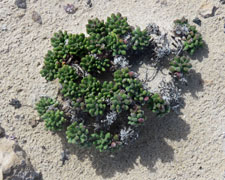 |
 Crossing the dunes |
 |
 |
 The beauty of pristine dunes |
 |
Climbing the big dune was well worth it, but it had led us away from my original route across the dunes - so instead of doubling back, we dropped down the steep side of the dune and into what looked like more open coastal heath. True, it was easier than our first lot of bush-bashing, at times due to following emu and kangaroo pads through the dense bushes, but in hindsight I think it would have been better to double back briefly and stay on the open dunes, which at one point split the peninsula. Anyway, after our second and easier lot of bushbashing, we popped out onto the sandy Coffin 4WD Track a bit to the west of the dune exit. |
||
 A heath-filled valley between the dunes |
 Picking a track through the heath |
 The Coffin 4WD Track |
We headed eastwards on the track and, on reaching the dune, found that all that separated it from the waters of Coffin Bay was a narrow band of samphire swamp rapidly filling with the incoming tide. It was time to take off our boots and wade along the edge of the calm clear bay waters. Our feet really enjoyed that. What a contrast the tranquil bay was to the wild surf of the ocean. |
||
|
|
|
A little further around, a long knee-deep wade of the entrance to Jesse Lagoon added a bit more adventure to the walk. After one last beach walk, we re-booted and climbed up the strip of sandy heath to continue on down the 4WD track. Our water-crossings were over ..... or so we thought. As we traversed inland on the way back to Yangie Bay, a convoy of 4WD vehicles passed us .... a little later we passed them. They had been blocked by the incoming tide, which now flooded a several hundred metre section of track next to Yangie Bay. They would be stuck for several hours, but we waded on in the at times thigh deep water. Suddenly, a woman's scream pierced the air, several times. It was in French and not a cry for help, but some very colourful language directed at her partner who had attempted to drive across the tide-covered track and flooded his engine with saltwater ..... very, very very bad. He was being winched out as we waded by and finished our adventurous walk back at Yangie Campsite. |
||
 Cars trapped by the rising tide |
 |
 This track is OK for walking but not for driving |
To complete our big day out, we drove down to see the superb vistas at Avoid Point .... looking across a long surf-breaking reef to Golden Island off shore and checking out the magnificent eroded cliff-line. The day was rounded out with fish and chips and a celebratory pale ale at the Coffin Bay Yacht Club, overlooking its tranquil waters as the sun set in the west. |
|
|
|
It had been an excellent day with magnificent and varied coastal scenery - sometimes it's best to make up your own path than to follow another's. |
|
Cape Donington Circuit - Lincoln NP (12 km - 140m ascent - 140m descent) |
It was a relatively quick half-hour drive from Port Lincoln into Lincoln National Park and on to its north-eastern extremity, the Cape Donington Peninsula, which lies 10 km across the harbour waters from Port Lincoln. We parked the car at the Fishermans Point campsite on a limestone headland jutting out into the waters of Spalding Cove and set out. Crossing the road, we picked up a well-formed foot track that led us quickly into the open mallee vegetation of the peninsula. Arriving at a track junction, we turned north to follow part of the Fishermans Point Loop Trail, as it continued on through this attractive vegetation. After yesterday's bush-bashing at Coffin Bay, this was luxury. |
||
 Looking north over Fishermans Beach |
 Track through the mallee |
 Looking out over Yachties Beach |
The tracked eventually turned eastwards to directly cross the peninsula and reach the open waters of Spencer Gulf. We were at Yachties Beach and what a contrast it was to the sea of yesterday. Here, protected from the westerly winds, the flat aquamarine waters of the gulf lapped gently against the shore-line ... very peaceful and worth a stop. |
||
|
|
|
We had now joined the Investigator Trail which we would stay on for the rest of the walk. It took us through the low shore-line heath as we followed the rocky coastline along - seemingly a bedrock of bouldery granite - grey, black and lichen-orange - with a topping of limestone further back. In the distance, far out to sea, we could make out the silhouettes of big fishing boats and the tuna pens they were servicing. Aquafarming is big business here and tuna is the king. |
||
 September Beach |
 Boats and tuna pens in Spencer Gulf |
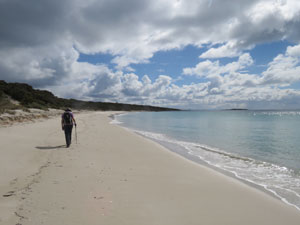 Walking along September Beach in April |
|
The track emerged at September Beach, another stretch of white sand and calm aquamarine water with a popular camping area. Leaving September Beach, the track continued around the low rocky coastline to reach the end of the cape and Donington Lighthouse. This is a modern structure and lacked the aesthetic charm of its 19th century counterparts. |
|
 |
 View westwards over Spalding Cove |
|
When we left September Beach, we noticed that the sky was changing from blue to grey and the associated rainband arrived as we were heading on from the lighthouse - not heavy enough to warrant putting on raingear, just a spotty drizzle that arrived, unfortunately, as we began to cross more open land near Donington Beach. Out from the beach, a heavier band of showers partially obscured the outline of Boston Island, 4 km away. |
||
 Donington Beach |
 |
 Back into the mallee interior near Engine Point |
The spotty rain stopped as we pushed southwards to cut behind Cape Colbert and reach the western side of the peninsula again, emerging at the top of a long stretch of beach - this was our route onwards, the northern end sandy and covered with piles of briny-smelling washed up sea-weed, the southern end a low jagged limestone platform. |
||
 |
 |
 |
On leaving the beach, we followed the track around Engine Point, where grey and orange granite boulders again lined the shore. After briefly heading inland for a small passage beneath the mallee, the track brought us out at the top end of Fishermans Beach and our lunch spot - a place vaguely reminiscent of beaches in northern Greece. |
 Spalding Cove a la greque |
 Rain approaching the western shore of Cape Donington Peninsula |
To the south, we could see Fishermans Point, our endpoint, jutting out into the sea, only a one kilometre beach walk away. We could also see the next band of rain cloud heading rapidly our way and, halfway down the beach, had to put on wet weather gear, as a cold wind blew the spotty raindrops into our faces. Still, by the time we reached the point and the car, the rain had gone, the sun was back and the walk was over. It had been a good walk and an easy one - a nice complement to our Coffin Bay trek, both in scenery and level of difficulty. It was also good to see how two areas, which superficially looked like they would be the same, offered such different landscapes. |
|
|




